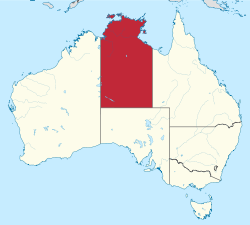Northern territory
| Northern Territory | |||||
|---|---|---|---|---|---|
|
|||||
| Slogan or nickname | The Territory; The Top End |
||||
 Other Australian states and territories |
|||||
| Coordinates | 20°S 133°E / 20°S 133°ECoordinates: 20°S 133°E / 20°S 133°E | ||||
| Capital city | Darwin | ||||
| Demonym | Northern Territorian, Territorian | ||||
| Government | Constitutional monarchy | ||||
| • Administrator | John Hardy | ||||
| • Chief Minister | Michael Gunner (ALP) | ||||
| Australian territory | |||||
| • Established by NSW | 1825 | ||||
| • Transferred to South Australia | 1862 | ||||
| • Transferred to Commonwealth | 1911 | ||||
| • Dissolved | 1927 | ||||
| • Reformed | 1931 | ||||
| • Responsible government |
1978 | ||||
| Area | |||||
| • Total | 1,420,970 km² (3rd) 548,640 sq mi |
||||
| • Land | 1,349,129 km² 520,902 sq mi |
||||
| • Water | 71,839 km² (5.06%) 27,737 sq mi |
||||
| Population (2016) |
|||||
| • Population | 244,000 (8th) | ||||
| • Density | 0.18/km² (8th) 0.5 /sq mi |
||||
| Elevation | |||||
| • Highest point |
Mount Zeil 1,531 m (5,023 ft) |
||||
| Gross territorial product (2014–15) |
|||||
| • Product ($m) | $22,450 (8th) | ||||
| • Product per capita | $92,107 (2nd) | ||||
| Time zone(s) |
UTC+9:30 (ACST) (does not observe DST) |
||||
| Federal representation | |||||
| • House seats | 2/150 | ||||
| • Senate seats | 2/76 | ||||
| Abbreviations | |||||
| • Postal | NT | ||||
| • ISO 3166-2 | AU-NT | ||||
| Emblems | |||||
| • Floral |
Sturt's desert rose (Gossypium sturtianum) |
||||
| • Animal |
Red kangaroo (Macropus rufus) |
||||
| • Bird |
Wedge-tailed eagle (Aquila audax) |
||||
| • Colours | Black, white, and ochre | ||||
| Website | www |
||||
The Northern Territory (abbreviated as NT) is a federal Australian territory in the central and central northern regions of Australia. It shares borders with Western Australia to the west (129th meridian east), South Australia to the south (26th parallel south), and Queensland to the east (138th meridian east). To the north, the territory is bordered by the Timor Sea, the Arafura Sea and the Gulf of Carpentaria. Despite its large area—over 1,349,129 square kilometres (520,902 sq mi), making it the third largest Australian federal division—it is sparsely populated. The Northern Territory's population of 244,000 (2016) makes it the least populous of Australia's eight major states and territories, having fewer than half as many people as Tasmania.
The archaeological history of the Northern Territory begins over 40,000 years ago when Indigenous Australians settled the region. Makassan traders began trading with the indigenous people of the Northern Territory for trepang from at least the 18th century onwards. The coast of the territory was first seen by Europeans in the 17th century. The British were the first Europeans to attempt to settle the coastal regions. After three failed attempts to establish a settlement (1824–1828, 1838–1849, and 1864–66), success was achieved in 1869 with the establishment of a settlement at Port Darwin. Today the economy is based on tourism, especially Kakadu National Park in the Top End and the Uluru-Kata Tjuta National Park (Ayers Rock) in central Australia, and mining.
...
Wikipedia


